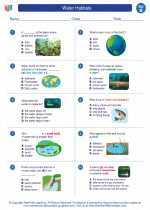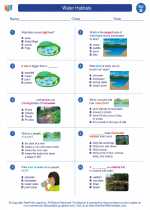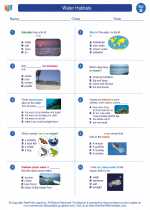Fossilization
Fossilization is the process by which the remains or traces of living organisms are preserved in the Earth's crust. This process allows scientists to study and understand the history of life on Earth by examining the fossils left behind.
How Fossilization Occurs
Fossilization occurs in several steps:
- Death of the Organism: The organism dies and its remains are buried by sediment.
- Decay: Soft tissues decay and are eaten by scavengers or decomposed by bacteria, leaving only the hard parts of the organism behind.
- Burial: The remains are buried by layers of sediment, protecting them from further decay and alteration.
- Mineralization: Over time, the remains are slowly replaced by minerals, turning them into stone-like structures.
- Uplift and Exposure: Geological processes such as erosion or tectonic movements bring the fossil closer to the Earth's surface.
- Discovery: Fossils are discovered by paleontologists or amateur fossil hunters and are studied to learn about the history of life on Earth.
Types of Fossils
There are several types of fossils that can be formed during the fossilization process:
- Body Fossils: These fossils preserve the actual remains of an organism, such as bones, teeth, or shells.
- Trace Fossils: These fossils preserve traces of an organism's activity, such as footprints, burrows, or coprolites (fossilized feces).
- Chemical Fossils: These fossils preserve chemical signatures of ancient life, such as lipids or proteins.
Study Guide
Here are some key points to remember about fossilization:
- What is fossilization and why is it important for understanding the history of life on Earth?
- Describe the steps involved in the fossilization process.
- Explain the difference between body fossils, trace fossils, and chemical fossils.
- Identify and describe at least three different types of fossils.
- Discuss the role of paleontologists in the study of fossils and the history of life on Earth.
- Explain how fossils can provide evidence for evolution and environmental changes over time.
By understanding the process of fossilization and the different types of fossils, we can gain valuable insights into the ancient life forms that once inhabited our planet.
.◂Science Worksheets and Study Guides Second Grade. Water Habitats
Study Guide Water Habitats
Water Habitats  Activity Lesson
Activity Lesson Water Habitats
Water Habitats  Worksheet/Answer key
Worksheet/Answer key Water Habitats
Water Habitats  Worksheet/Answer key
Worksheet/Answer key Water Habitats
Water Habitats  Worksheet/Answer key
Worksheet/Answer key Water Habitats
Water Habitats  Worksheet/Answer key
Worksheet/Answer key Water Habitats
Water Habitats  Vocabulary/Answer key
Vocabulary/Answer key Water Habitats
Water Habitats  Vocabulary/Answer key
Vocabulary/Answer key Water Habitats
Water Habitats 

 Activity Lesson
Activity Lesson
 Worksheet/Answer key
Worksheet/Answer key
 Worksheet/Answer key
Worksheet/Answer key
 Worksheet/Answer key
Worksheet/Answer key
 Worksheet/Answer key
Worksheet/Answer key
 Vocabulary/Answer key
Vocabulary/Answer key
 Vocabulary/Answer key
Vocabulary/Answer key

The resources above cover the following skills:
LIFE SCIENCE (NGSS)
Biological Evolution: Unity and Diversity
Students who demonstrate understanding can:
Make observations of plants and animals to compare the diversity of life in different habitats[Clarification Statement: Emphasis is on the diversity of living things in each of a variety of different habitats.] [Assessment Boundary: Assessment does not include specific animal and plant names in specific habitats.]